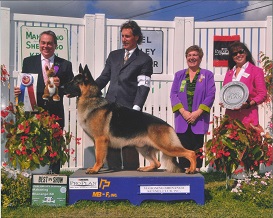By Marshall Matz and Jolyda O. Swaim
We love our pets! There are approximately 80 million
dogs in the United States and a similar number of cats. More than half of
all American households share their home with at least one cat or dog. Evidence is conclusive that pets contribute
to our well-being, both physically and psychologically. Fo
Animals are playing an important role in the military, assisting police and with rescue missions. Our animals are also assisting in a wide range of personal services.
As a result, the pet food industry has now grown to $24 billion. According to the American Pet Products Association, we will spend more than $60 billion this year on our pets, if you include pet care. In short, pet food is an important business with many of the same issues faced by other agriculture stakeholders and companies that produce food for human consumption.
 “Fritz,” owned by Ed Farrell at OFW, is a Purina “Best
in Show” winner.
“Fritz,” owned by Ed Farrell at OFW, is a Purina “Best
in Show” winner.
The first commercially prepared pet food was a dog biscuit introduced in England around 1860 by James Pratt, an American electrician who initially intended to sell lightning conductors to the British. When Pratt arrived in England, however, the first thing he noticed was dogs scavenging for food. In that moment, Pratt recognized the need for food prepared for animals and turned his efforts to the production of dog food using wheat, vegetables, beetroot and meat.
Commercial dry and wet (canned) dog foods began appearing in the 1920’s and 1930’s, and pet food went mainstream in the 1950’s when the first extruded pet foods entered the market, with dry cat food following in the early 1960’s. Since that time, pet foods have been developed to provide optimal nutritional benefits for pets in every stage of their lives. There are now commercially-available foods to address weight management, healthy aging, sensitive skin and stomachs, and – one of the first targeted life-stage foods developed – puppy and kitten food.
The development that began in the 1800’s has been followed by more than 150 years of progress and improvement in pet foods, creating a very large industry with a significant range of pet food companies.
 Moose and Buster, Maine
Coon Cats, at home relaxing.
Moose and Buster, Maine
Coon Cats, at home relaxing.
Safety
According to Cathy Enright, President of the U.S. Pet Food Institute (PFI), the national trade association whose members make 98% of all U.S. pet food products, “Safety is the number one priority for pet food companies. We are committed to constant improvement. Advanced science and nutritional knowledge is used to produce complete and balanced pet foods that result in pets living long, healthy lives.”
Pet foods are regulated by the Food and Drug
Administration, the U.S. Department of Agriculture and state agencies (coordinated
through the Association of American Feed Control Officials.) In short, pet food companies and their
processing methods meet exacting safety standards similar to those required
for foods for human consumption. Pet food labeling and advertising claims are regulated by
the federal government and by the states. The Food and Drug Administration, the states
and Federal Trade Commission evaluate pet food product claims at the federal
level and can take action against products that make claims that are untruthful
o
Pet food companies use many of the same good manufacturing practices (GMPs) when producing pet food that are used in the production of human food. Moreover, the majority have used the food safety programs developed in the 1960’s– Hazard Analysis and Critical Control Points (HACCP) – to ensure the “food safety” of their products for years. While GMPs address the condition of the facility and equipment and how employees must dress and handle pet food, HACCP is used to ensure that any product leaving a facility has met all parameters to ensure it is safe for the pet as well as for entry and handling in the home. These could include that it is cooked to the proper temperature and a metal detector was part of the process, as well as other food safety checks.
By the time a finished pet food arrives at the store for your purchase, it will have gone through many food safety and quality checks that focused on the ingredients used, the packaging materials, how these are received at the production facility, the actual finished product processing and finally, how the finished product is packaged. Tests will be done on ingredients and product throughout the process to determine whether or not they meet quality and foods safety specifications.
While the majority of pet food companies have had
rigorous GMP and HACCP programs in place fo
Broadly, the rule requires registered pet food facilities to maintain a written food safety plan. This includes performing a hazard analysis, and instituting preventive controls for dealing with any identified hazards. Facilities will have to verify and document that their controls are working, and if one fails, they will need to document corrective actions that include reassessing the failed control.
Included in the rule for animal food is the need to also have a risk-based supply chain program for those raw materials and other ingredients used in the actual production of pet food for which a production facility has identified a hazard requiring a supply-chain-applied control. This will mean those ingredients used by a pet food manufacturer will need to come from an approved supplier unless another verification process at receiving is temporarily put in place
In addition, the FDA’s FSMA rule for animal food establishes for the first time the requirements that current good manufacturing practices (CGMPs) be used in the manufacturing, processing, packing, and holding of food for animals. These are very similar to those required in the production of human food and cover areas such as the condition of the facility and the surrounding grounds, the condition of equipment and utensils used in production as well as the water supply, plumbing and sanitation of the facility.
Nutrition
The nutritional requirements of cats and dogs are different from those of humans of course, but a badly-balanced diet, composed of table scraps and too many treats is not optimal for a long healthy life. (It may be interesting to note that veterinary schools place a higher emphasis on nutrition than do medical schools.)
A balanced diet for a cat or dog is achieved through a thorough understanding of the science of dog and cat nutritional requirements and the nutrients found in ingredients. This knowledge is applied when formulating dog and cat foods with the correct proportions of a variety of quality ingredients including animal and plant protein sources, grains and even vegetables in order to meet their needs in terms of protein, carbohydrate, amino acids, minerals, trace-elements and vitamins. The nutritional requirements of an animal will vary according to its size, breed, life-stage, life-style and body condition. The nutritional needs of pets also depend on their activity level as well.
In short, our pets are important to us. We are treating them well and our federal agencies are keeping an eye open just to make sure.
___________________________________________________
Marshall Matz specializes in agriculture and food
security at OFW Law;

